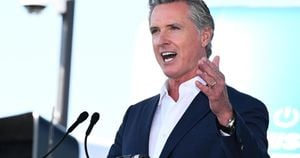The recent ceasefire between Israel and Hezbollah has ignited mixed reactions both within Israel and Lebanon, highlighting the complex and often contentious aftermath of the lengthy conflict. On November 27, 2024, the ceasefire, aimed at pausing over a year of intense hostilities, emerged after significant casualties and displacements were reported on both sides.
For residents on the Lebanese side, the ceasefire brought celebrations. Streets were filled with jubilant crowds, and many displaced individuals began returning to their homes, which were often heavily damaged or destroyed. One returning resident, Ali Arzouny, characterized the situation as one of victory and solidarity, emphasizing the sacrifices made by the martyrs and the need to support one another as they aimed to rebuild their lives. "What matters is we are going back to our land, and even if we have to live under the tent, we will be back home," he said, reflecting the hopeful sentiment prevalent among many Lebanese civilians.
Conversely, opinions within Israel were far less optimistic. After more than 70,000 residents were evacuated from northern communities due to Hezbollah’s rocket attacks, many Israelis have expressed skepticism about the ceasefire’s efficacy. Reports indicated significant apprehension, particularly from communities near the Lebanon border where longstanding security fears eroded any sense of victory associated with the truce. The chairman of Moshav Margaliot warned about potential security loopholes, insisting on strict terms such as establishing buffer zones to safeguard vulnerable settlements.
Political dynamics also play a significant role. Israeli Prime Minister Benjamin Netanyahu attempted to sell the ceasefire to the public, emphasizing the importance of security and the return of residents to their homes. Yet, his message faced backlash, with criticisms stemming from both the right and left factions of the political spectrum. Itamar Ben-Gvir articulated concerns over Hezbollah's continued presence, questioning the competence of the Lebanese army to manage the group. Similarly, former Defense Minister Yoav Gallant underscored his skepticism, stating, "The future of the north and the security of its residents will be determined… by the determination of the Israeli government."
Analysts highlight the mixed political motivations underpinning the ceasefire. Some interpretations suggest Netanyahu could be leveraging the ceasefire to buy time, particularly with the advent of a new U.S. administration under Donald Trump, which might shift geopolitical strategies. This situation, perceived as merely postponed conflict rather than genuine resolution, raises concerns about the potential for renewed hostilities. Political analyst Meron Rapaport remarked, "It reflects the government's failure to deliver the decisive outcome it had promised."
Despite celebrations marking the ceasefire from Lebanon, the reality remains stark. Hundreds of thousands of Lebanese are returning to homes transformed by war, some returning to rubble and destruction. Hadi Jamil, another resident, lamented the loss, stating, "All our homes are destroyed; all of Ayta is destroyed." This sentiment resonates with many as they grapple with the physical and emotional scars of conflict.
The foundational issues underlying the ceasefire remain tumultuous as both sides navigate the precarious balance of power. The fragile nature of the ceasefire reflects underlying tensions, as international and regional dynamics could easily tilt the scale back toward violence. Analysts predict Hezbollah may take this time to recover and rebuild, exacerbated by Iran's continued influence and support.
Reports noted the ceasefire came on the back of heavy military actions from Israel, which conducted strikes targeting Hezbollah positions up until the last moments before the truce. Despite the ceasefire, tensions remain high; Israeli troops continue to patrol regions near the border, with directives warned against engaging with returning civilians until security situations stabilize.
While the ceasefire marks the conclusion of one theater of battle, experts are cautious, asserting this should not be viewed as the end of the overarching conflict. Raphael Cohen from RAND Corporation stated, "The Israel-Iran fight is still very much unresolved. Hezbollah has been severely degraded, but it is not defeated." This highlights the interconnected nature of regional hostilities, where one conflict’s resolution often leads to the preparation for another.
The road to recovery for both communities, Israeli and Lebanese, will be challenged by the aftermath of destruction, loss of life, and the intricacies of rebuilding trust and stability across borders. A precarious calm fills the air, but many are left pondering how long this peace may endure.
Although the ceasefire provides immediate relief for some, questions linger about its long-term sustainability. Displaced individuals express impatience and wariness, concerned about returning to homes overshadowed by past violence. The sentiment captures the emotional toll these cycles of conflict inflict upon civilian lives, particularly as citizens from both sides brace for what may come next.
With tenuous political agreements on the table and widespread skepticism from citizens, analysts fear the potentiality of resuming hostilities could rear its head sooner rather than later. The echoes of celebrations juxtaposed against fears of violence signal the duality of this ceasefire, marking both deliverance and uncertainty.
Only time will tell how the future will unfurl for Israel and Lebanon, but for now, the ceasefire stands as both a point of relief and reflection—where the wounds of the past meet the hope for peace amid fragile truce.



